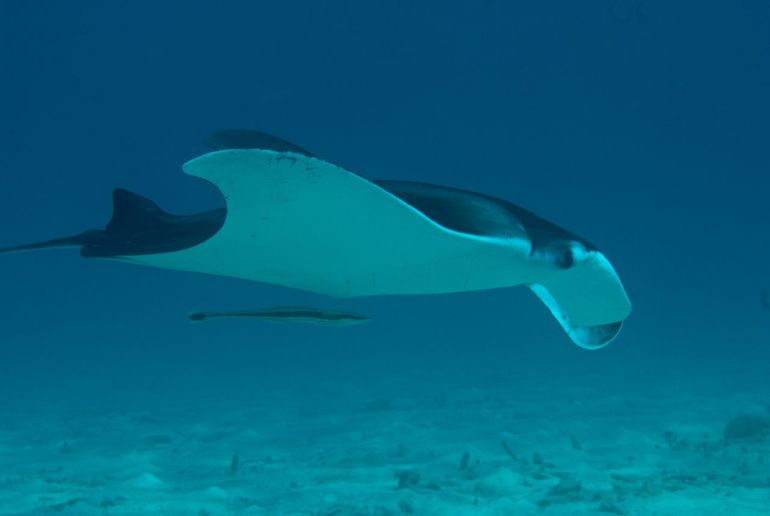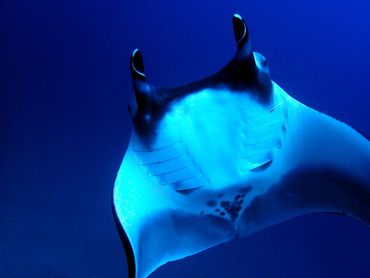
Rays of hope: strengthening conservation efforts for manta rays
Dutch Caribbean Nature Alliance (DCNA)Luckily, increased protection for the giant oceanic manta ray in the Caribbean region will be considered in the next Conference of Parties for the Cartagena Convention (COPS) meeting later this year on Aruba.
Manta Rays in the Caribbean
The Caribbean is home to two species of manta ray, the giant oceanic manta ray (Mobula birostris) and Caribbean manta ray (Mobula cf. Birostris – which will most likely be officially described in the coming years), as well as several species of devil rays. Manta rays are the largest type of rays and pose no danger to humans.
Manta rays are filter feeders, taking in microscopic food (plankton), including fish larvae, krill, shrimp, and planktonic crabs from the water column and filtering them through their gill plates. They play a vital role in keeping the oceans healthy by regulating plankton levels. Also, by moving between the surface ocean, deep sea and coral reefs, they create a valuable ecological connection by transporting nutrients.

Threats
Manta rays are threatened by a variety of human activities. One of the biggest threats to these creatures worldwide is overfishing, as they are often targeted for their gill plates, used in traditional Chinese medicine. They are also at risk from bycatch, entanglement, habitat destruction, and pollution. Bycatch and entanglement are likely the two biggest threats in the Caribbean.
Manta rays are the largest species of rays, are long-lived (30 tot 50 years) and are slow to reproduce. It is estimated that giant manta rays are not able to reproduce until they reach an age of 9 to 12 years old, after which, they are only able to produce one pup at a time. This slow life cycle and low reproduction rate make manta rays extremely vulnerable to depletion.
Hope on the horizon
In the Dutch Caribbean, marine protected areas, such as the Yarari Marine Mammal and Shark Sanctuary, help protect manta and devil rays. The species are also on several regional and international lists, such as the Convention on International Trade in Endangered Species (CITES), the Convention on the Conservation of Migratory Species of Wild Animals (CMS) and International Shark Strategy adopted by the Dutch Government (2019).
In addition, the Kingdom of Netherlands, along with the Republic of France, has formally submitted a proposal to include the giant manta in Annex II of the Specially Protected Areas and Wildlife (SPAW) Protocol, a regional agreement for the protection and sustainable use of coastal and marine biodiversity in the Wider Caribbean Region. If approved during the next Conference of Parties for the Cartagena Convention (COPS) this year on Aruba, this measure will provide a legal framework for the highest level of protection for the conservation of the giant manta ray.
Report your sightings
By submitting your (old and new) sightings of manta and devil rays, you can help researchers and conservationists learn more and better protect these species. You can report your sightings via Caribbean Islands Manta Conservation Program or Observation.org and its associated free app ObsIdentify which will help you automatically identify the species by uploading your photos. In addition, you could also submit your photos via Mantatrust.org/IDtheManta, e-mail or through the Caribbean Islands Manta Conservation Program social media pages on Facebook and Instagram. If uploading images to social media, particularly Instagram, tag @Caribbeanislandsmanta in your uploads to make sure these images are easily found and included in the global database.
DCNA
 The Dutch Caribbean Nature Alliance (DCNA) supports science communication and outreach in the Dutch Caribbean region by making nature-related scientific information more widely available through amongst others the Dutch Caribbean Biodiversity Database, DCNA’s news platform BioNews and the press. This article contains the results from several scientific studies but the studies themselves are not DCNA studies. No rights can be derived from the content. DCNA is not liable for the content and the in(direct) impacts resulting from publishing this article.
The Dutch Caribbean Nature Alliance (DCNA) supports science communication and outreach in the Dutch Caribbean region by making nature-related scientific information more widely available through amongst others the Dutch Caribbean Biodiversity Database, DCNA’s news platform BioNews and the press. This article contains the results from several scientific studies but the studies themselves are not DCNA studies. No rights can be derived from the content. DCNA is not liable for the content and the in(direct) impacts resulting from publishing this article.
More information
- Read more about manta rays at DCNA
- The Manta Trust
- Swimming with mantas - sustainably
- The proposal (pdf: 489 KB) to include the giant manta ray in the SPAW Protocol
Text: DCNA
Photos: Pieter de Groot (lead photo: giant manta ray); Rudy van Geldere; Danielle de Kool
